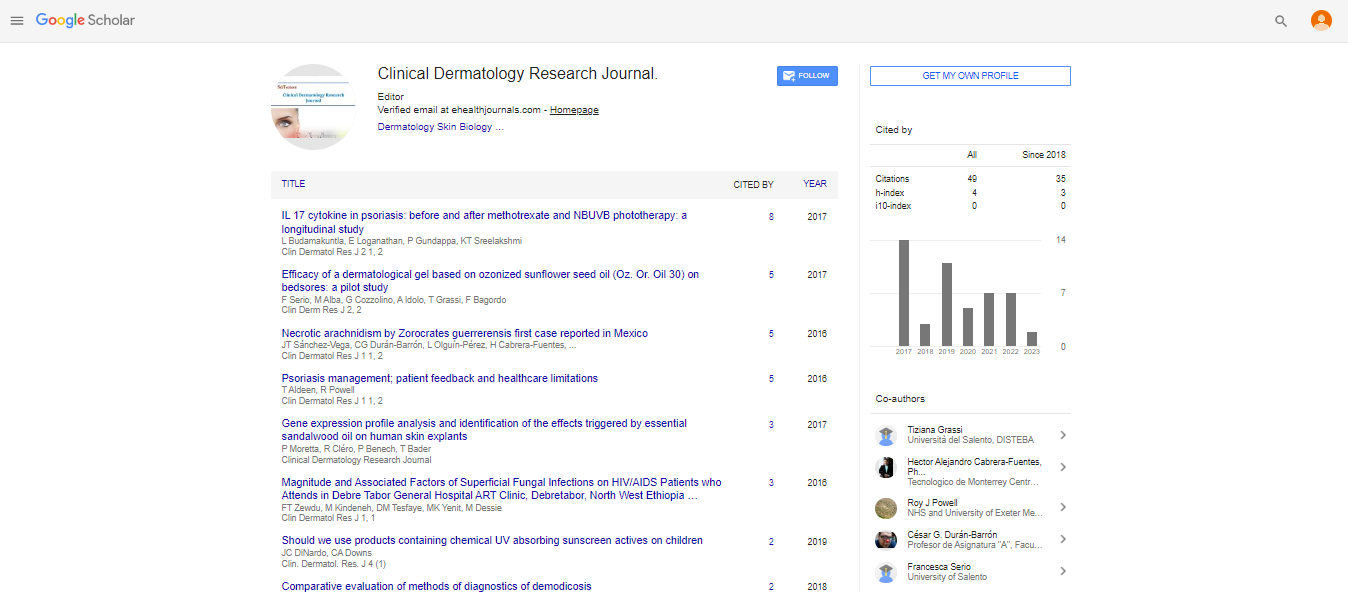Commentary, Int J Ophthalmic Pathol Vol: 6 Issue: 4
Impact on Skin Cancer Due to Climate Change
Jean-Marc Sabate*
Department of Dermatology, Hospital Avicenne, Bobigny, France.
*Corresponding Author:
Jean-Marc Sabate
Department of Dermatology, Hospital Avicenne, Bobigny, France.
E-mail: sabate@mr.aphp.fr
Received: July 02, 2021 Accepted: July 16, 2021 Published: July 23, 2021
Citation: Sebate JM (2021) Impact on Skin Cancer Due to Climate Change. Clin Dermatol Res J 6:4. (161)
Abstract
There is near unanimous agreement in the scientific community that climate change is occurring although the pace of this change is frequently debated. As people, we collaborate with the climate every day and among the most serious danger of natural openness is malignancy.
Keywords: Skin Cancer, skin
Introduction
There is near unanimous agreement in the scientific community that climate change is occurring although the pace of this change is frequently debated. As people, we collaborate with the climate every day and among the most serious danger of natural openness is malignancy. Natural contamination can add to disease in an assortment of ways, for example, through radiation openness and polluting harvests or water supplies. Rising worldwide temperatures and ozone layer changes not just seem to expand the rate of disease yet in addition the seriousness if malignancy creates. Bright beams assume a part in the danger of skin malignancy yet daylight is displayed to likewise further develop mental prosperity so there is an equilibrium that should occur.
Discussion
A critical test that environmental change presents with regards to skin wellbeing would be an expanded rate in forceful types of skin malignancy. As the ozone safeguard crumbles the pace of bright radiation openness rises. Dangers welcomed on by this would be untimely maturing and greater weakness that is welcomed on with that. Epithelial tissue is at present the most probable tissue to become harmful. Skin malignancy is the most widely recognized type of any disease. Non melanoma skin carcinoma is recorded as a main factor of most of cutaneous harm. Environment is likewise found to exceptionally affect cutaneous danger. Studies track down that the occurrence paces of skin malignancy have expanded alarmingly all through the last 50% of the mid-twentieth century obviously identified with stratospheric ozone consumption just as different issues welcomed on by environmental change. The stratospheric ozone is fundamental in regards to skin wellbeing and outside openness as it fills in as a channel for bright radiation. With the stratospheric ozone misfortune, probably the biggest safeguard shielding us from destructive and overexposed bright beams is vanishing. As this safeguard keeps on exhausting, it will set aside significantly less effort for people to be presented to a hurtful degree of radiation. One issue that is confronted with respect to deciding the connection between's non melanoma skin carcinoma and issues welcomed on through environmental change would be that the rates which it probably won't be remembered for public malignancy vaults. Indeed, even with this restricting the specific qualities, we are as yet ready to see a huge vertical pattern in the rate. In the United States alone there has been a monstrous expansion in the quantity of instances of non-melanoma skin carcinoma. This rise of new cases. This information was gathered utilizing programs SEER 9 which incorporate analyzed cases from 1975 through the current information year (2016) and SEER 13 which shows information of analyzed cases from 1992 and incorporates extended races. Skin malignancy can grow rapidly and can stay undetected because of the cancer-causing nature of bright beams. Exploration tracked down that bright radiation has been resolved to be a finished cancer-causing agent because of its job as a mutagen and its capacity to cause tumor development without requiring any extra incitement.
Conclusion
The literature and research presented with this topic suggests that there is a correlation between the elements of climate change and dermatologic conditions. With the consumption of the ozone safeguard we presently perceive how it affects everybody and not simply those living in helpless conditions as skin disease keeps on rising. As analysts wrestle with arrangements there must likewise be the thought of medical issue that are brought about by environmental change as they could be constant and possibly hazardous. There is a requirement for more open attention to this connection also. It very well may be gainful to drive subsidizing into public assistance declarations for issues, for example, the ascent in instances of skin disease and how it very well may be conceivably balanced by little activities like utilizing high SPF sunscreens.
References
- Asgari MM, Engels EA, Leyden W, Quesenberry CP, Silverberg MJ, et al. (2013) HIV Infection Status, Immunodeficiency, and the Incidence of Non-Melanoma Skin Cancer. J Natl Cancer Inst 105: 350-360.
- Rawlings Parker E (2021) The influence of climate change on skin cancer incidence -A review of the evidence. Int J Womens Dermatol 7: 17-27.
- Makin J (2011) Implications of climate change for skin cancer prevention in Australia. Health Promot J Austr 22: 39-41.
 Spanish
Spanish  Chinese
Chinese  Russian
Russian  German
German  French
French  Japanese
Japanese  Portuguese
Portuguese  Hindi
Hindi 

